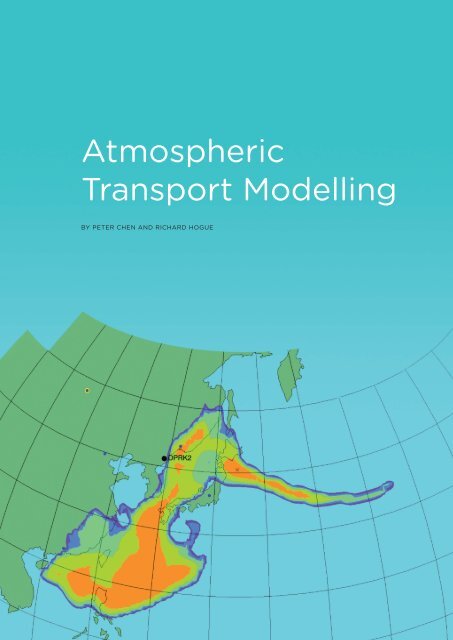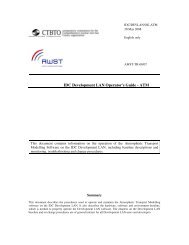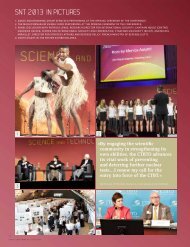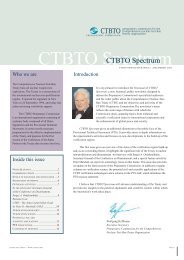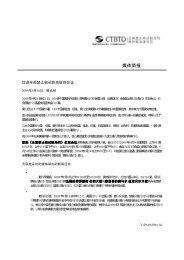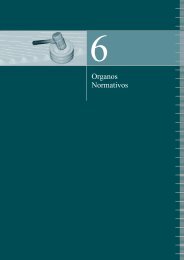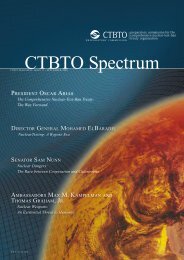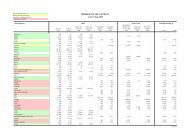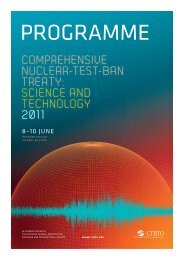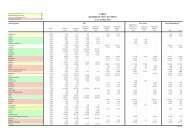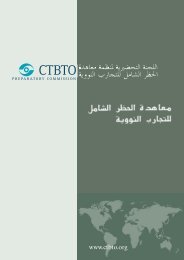Atmospheric Transport Modelling - Comprehensive Nuclear-Test ...
Atmospheric Transport Modelling - Comprehensive Nuclear-Test ...
Atmospheric Transport Modelling - Comprehensive Nuclear-Test ...
You also want an ePaper? Increase the reach of your titles
YUMPU automatically turns print PDFs into web optimized ePapers that Google loves.
<strong>Atmospheric</strong><br />
<strong>Transport</strong> <strong>Modelling</strong><br />
BY PETER CHEN AND RICHARD HOGUE
AT M O S P H E R I C<br />
T R A N S P O R T M O D E L L I N G<br />
<strong>Atmospheric</strong><br />
<strong>Transport</strong> <strong>Modelling</strong><br />
BY PETER CHEN AND RICHARD HOGUE<br />
FACT BOX<br />
<strong>Atmospheric</strong><br />
<strong>Transport</strong> <strong>Modelling</strong><br />
(ATM) is concerned<br />
with modelling<br />
and tracking<br />
the movement<br />
of air volumes<br />
to estimate the<br />
locations of sources<br />
of radionuclide<br />
particulates<br />
and noble gas<br />
observations. The<br />
ATM topic area<br />
of the ISS project<br />
has conducted a<br />
series of studies<br />
designed to estimate<br />
the capabilities of<br />
present ATM models<br />
and procedures, and<br />
to explore ways to<br />
further improve their<br />
accuracy.<br />
ATM technology can be used for tracking<br />
radioactive particles and noble gases<br />
produced from atmospheric or underground<br />
explosions and dispersed by the atmospheric<br />
winds. In order to link a measurement<br />
at an International Monitoring System<br />
(IMS) station and a possible source<br />
location, a detailed understanding of the<br />
three-dimensional movements of the air<br />
around the globe is needed. To locate a<br />
potential source, the ATM’s backtracking<br />
mode is used most efficiently to associate<br />
radionuclide detections at monitoring<br />
locations with possible source locations.<br />
In the opposite case, ATM can be used to<br />
forecast where the plume of radioactivity<br />
may first arrive at monitoring sites. This<br />
prediction technology was used in the daily<br />
assessments of potential station detections<br />
in the case of the 25 May 2009 test by<br />
the Democratic People’s Republic of Korea<br />
(DPRK) where the spatial source location<br />
was determined accurately by the IMS<br />
seismic network.<br />
ATM: A KEY TECHNOLOGY FROM<br />
1996 WHEN THE TREATY OPENED<br />
FOR SIGNATURE<br />
The ISS Conference (ISS09) acknowledged<br />
the important role that ATM technology<br />
played during the early negotiations for<br />
the <strong>Comprehensive</strong> <strong>Nuclear</strong>-<strong>Test</strong>-Ban<br />
Treaty (CTBT) in terms of estimating the<br />
performance of various designs of a global<br />
radionuclide monitoring network for Treaty<br />
verification. ATM has advanced considerably<br />
since then.<br />
The Preparatory Commission for the<br />
<strong>Comprehensive</strong> <strong>Nuclear</strong>-<strong>Test</strong>-Ban Treaty<br />
Organization’s (CTBTO) International Data<br />
Centre (IDC) has developed and implemented<br />
a sophisticated ATM backtracking<br />
system, using real-time meteorological<br />
input from the European Centre for<br />
Medium Range Forecasts (ECMWF), one of<br />
the most advanced global meteorological<br />
centres in the world. In addition, the IDC<br />
integrates ATM estimates from the World<br />
Meteorological Organization (WMO) to<br />
increase confidence in the source location<br />
assessment. These additional estimates are<br />
computed in real-time from nine of the<br />
WMO’s operational numerical weather prediction<br />
centres using global observational<br />
data, analyses, and numerical models of the<br />
earth-atmosphere system. The combined<br />
CTBTO-WMO system has been tested several<br />
times through designed exercises, as well as<br />
following the DPRK’s underground nuclear<br />
test on 9 October 2006.<br />
ATM technology has also been used<br />
extensively to study the background level<br />
of radionuclides that are detected at each<br />
of the IMS monitoring stations. Work in<br />
that area has been particularly active in<br />
improving the understanding of the noble<br />
gas measurements at the stations, which<br />
are affected by the few medical isotope<br />
production facilities in the world. These<br />
fixed sources account for most of the noble<br />
gas detections at the IMS stations. Therefore,<br />
it is important to understand the<br />
typical daily measurement signature that is<br />
due to various source emissions, in particular<br />
those from medical isotope facilities.<br />
This is often referred to as understanding<br />
the “background signature” at each station<br />
and is essential in order to interpret and<br />
identify noble gas measurements that could<br />
be associated with an emission from an<br />
underground nuclear explosion.<br />
During ISS09, the CTBTO’s capabilities to<br />
detect, locate and characterize a nuclear<br />
event were discussed. ATM technology<br />
makes vital contributions to both radionuclide<br />
particulate and noble gas event<br />
localization. In addition, ATM contributes<br />
significantly to noble gas event characterization<br />
by flagging bogus xenon detections<br />
from known fixed sources.<br />
Overall, ISS09 noted that ATM technology<br />
is an indispensable part of Treaty verification,<br />
which connects radionuclide and noble<br />
gas monitoring data to the unambiguous<br />
identification of a nuclear explosion.<br />
30 SCIENCE FOR SECURITY
DIFFERENT ASPECTS OF ATM<br />
TECHNOLOGY ADDRESSED<br />
THROUGH SCIENTIFIC POSTERS<br />
Dr. Andreas Stohl, senior scientist at the<br />
Norwegian Institute for Air Research, gave<br />
a keynote lecture at ISS09 on the ATM<br />
topic area. Dr. Stohl is the main developer<br />
of the transport model (called “Flexpart”)<br />
that is used operationally at the IDC. Dr.<br />
Stohl provided a good overview of recent<br />
developments in ATM and, in particular,<br />
presented many examples of the validation<br />
of these models in the air quality modelling<br />
area such as tracking of air pollution<br />
plumes (CO, NO 2 ) and burning of biomass<br />
during large forest fires. As chemical<br />
constituents in the atmosphere follow<br />
the movements of the air, the validation<br />
process of the modelling and tracking of<br />
these elements applies directly to the use<br />
<br />
<br />
Friday 21 March at 12:00 UTC<br />
<br />
of ATM technology to track radionuclides<br />
in the atmosphere. Dr. Stohl’s presentation<br />
showed many of the capabilities of ATM<br />
technology in a wide range of successful<br />
applications, including in the Treaty<br />
verification area where the demand for<br />
ATM capability is comparatively low.<br />
SUMMARY OF POSTERS<br />
PRESENTED AT THE ISS09<br />
Fourteen posters on the ATM topic area were<br />
presented at ISS09. In addition, many of<br />
the radionuclide posters made reference to<br />
subjects closely related to ATM as these two<br />
areas work hand in hand.<br />
The posters provided a good overview of<br />
many of the areas related to ATM: operational<br />
AT M O S P H E R I C<br />
T R A N S P O R T M O D E L L I N G<br />
<br />
CTBT Article I<br />
<br />
<br />
International Data Centre<br />
Figure 1<br />
Illustration of the complex 3D shape of a radioactive plume typically evolving from a surface level release of nuclear debris,<br />
as simulated with a CTBTO ATM tool. The related simulated IMS radionuclide measurement scenario was used for the first<br />
CTBTO-WMO Experiment in Source Location Estimationí (CTBT/PTS/TR/2004-1) conducted in March 2003.<br />
SCIENCE FOR SECURITY 31
AT M O S P H E R I C<br />
T R A N S P O R T M O D E L L I N G<br />
capabilities, case studies on CTBT-related<br />
events, improved understanding of noble gas<br />
background levels, and scientific improvements<br />
related to ATM.<br />
The implementation of operational<br />
capabilities at the CTBTO including the close<br />
cooperation with the WMO, was well covered<br />
by several posters (Becker et al., ATM-03/E;<br />
Skomorowski and Pechinger, ATM-07/E;<br />
Wotawa and Becker, ATM-09/E). The<br />
CTBTO’s ATM system is now fully functional<br />
and provides real-time reliable guidance<br />
and products to support the verification<br />
technologies. These products contain all<br />
relevant information to enable the IMS<br />
radionuclide measurements to be traced back<br />
to their source as well as information that<br />
helps determine the radionuclide network‘s<br />
capability in terms of network coverage and<br />
threshold monitoring. The ATM system is<br />
based on a scientifically sound and proven<br />
technology that uses the world’s best atmospheric<br />
analyses available from the ECMWF.<br />
Furthermore, the CTBTO is able to access<br />
support from the WMO’s Regional Specialized<br />
Meteorological Centres on a 24-hour basis.<br />
This has helped increase confidence in the<br />
CTBTO’s assessments by comparing backtracking<br />
modelling with WMO results.<br />
In-depth case studies on CTBT-related<br />
events were presented by some of the ISS<br />
posters. These included the assessment of the<br />
DPRK 2006 event (Becker et al., ATM-10/E;<br />
Stocki et al., ATM-14/E) and the study of<br />
the 2008 shutdowns of some of the major<br />
medical isotope emitters (Chalk River, Canada,<br />
and Fleurus, Belgium). These temporary<br />
shutdowns offered a unique opportunity to<br />
assess the relative impact of these production<br />
facilities on the monitoring system (Ungar et<br />
al., ATM-15/E; Wotawa et al., ATM-16/E).<br />
ATM technology is increasingly used to<br />
further explore and understand the noble<br />
gas measurements at the IMS stations.<br />
In that regard, a few posters presented<br />
studies to enhance understanding of the<br />
background level of global noble gas<br />
measurements at the IMS stations. In<br />
particular, one study presented updated<br />
results of the global detection capabilities<br />
of the radionuclide stations to detect the<br />
various xenon isotopes by using many<br />
years of xenon measurements at the<br />
stations (Ungar et al., ATM-12/E). There<br />
have been significant contributions over<br />
the last six months alone that have helped<br />
improve the understanding of global noble<br />
gas background levels. This was one of<br />
the areas of work which was identified as<br />
needing improvement during the briefing<br />
session on the ISS project organized last<br />
December 2008 in Washington by the<br />
Center for Strategic & International Studies.<br />
The posters at ISS09 clearly demonstrated<br />
that substantial progress has been made in<br />
that field.<br />
Finally, many of the posters covered<br />
scientific improvements to the science of<br />
ATM. Two posters specifically addressed<br />
the area of ensemble modelling methods,<br />
which aim to reduce the uncertainties in the<br />
ATM assessments. One poster (Galmarini et<br />
al., ATM-05/E) compared the performance<br />
of two approaches to generating the<br />
ensemble members (multi-model ensemble<br />
and ensemble prediction system based<br />
ensemble), while the other (Galmarini<br />
and Potempski, ATM-04/E) examined<br />
new approaches to evaluate multi-model<br />
ensemble systems. Other posters explored<br />
opportunities for improvement (Arnold et<br />
al., ATM-02/E; Panday, ATM-06/E; Seibert,<br />
ATM-08/E). These included the use of more<br />
sophisticated source terms for the emissions<br />
scenarios such as time-dependent emission<br />
profiles, the need to examine the issues<br />
related to the resolution and quality of<br />
the meteorological data input to the ATM<br />
system, and the potential application of ATM<br />
to on-site inspection (OSI) related issues. In<br />
that regard, the importance of considering<br />
the complex terrain topographies and the<br />
weather phenomena in detail at the smaller<br />
scales was well highlighted. Posters also<br />
included ongoing work to assess the added<br />
value of running higher resolution ATM<br />
systems so as to better capture the various<br />
smaller scale phenomena, in particular for<br />
the monitoring stations located near complex<br />
terrain which affect the atmospheric flows.<br />
ATM AND OTHER CIVIL AND<br />
SCIENTIFIC APPLICATIONS<br />
The benefits of CTBT verification technologies<br />
for civil and scientific applications<br />
were strongly expressed at ISS09. The ATM<br />
scientific area profits from the availability<br />
32 SCIENCE FOR SECURITY
of radionuclide datasets in order to verify<br />
and validate the atmospheric models, which<br />
is an essential part of the ATM science.<br />
Furthermore, WMO receives the weather<br />
observations from IMS stations. These<br />
observations may be used in the global data<br />
assimilation systems, which, in turn, help to<br />
improve the assessment of the atmospheric<br />
flows around the globe and improve the<br />
weather forecasts.<br />
A well recognized civil application<br />
takes advantage of the capability to<br />
detect volcanic eruptions worldwide using<br />
infrasound monitoring. The time and<br />
intensity of the volcanic ash eruptions<br />
are important inputs to the tracking and<br />
forecasting of ash clouds in the atmosphere<br />
using ATM methods. The International Civil<br />
Aviation Organization’s (ICAO) Volcanic Ash<br />
Advisory Centres (VAAC) provide timely<br />
guidance to the aviation industry concerning<br />
ash clouds. They would benefit from<br />
improved time and intensity information<br />
about the release of ash plumes to better<br />
track and forecast these plumes using ATM.<br />
Here again; this detailed information can<br />
be used to validate ATM systems more<br />
accurately (Fee et al., INFRA-28/G).<br />
ATM: A CORNERSTONE TO THE<br />
CTBT VERIFICATION TECHNOLOGY<br />
The presentations and discussions at ISS09<br />
clearly demonstrated the positive contributions<br />
of ATM to the CTBT verification<br />
regime as well as the unique collaboration<br />
with the WMO. The impressive turnout of<br />
posters presented at ISS09 indicates that<br />
interest from the scientific community will<br />
continue to grow. This is also related to the<br />
fact that ATM technology provides the link<br />
that associates radionuclide events with<br />
seismic events and improves the reliability<br />
and accuracy of infrasound event backtracking.<br />
Many international ATM experts<br />
have expressed an interest in participating<br />
in ISS follow-up activities. Until then, the<br />
special session dedicated to ‘Research and<br />
Development in <strong>Nuclear</strong> Explosion Monitoring’,<br />
AT M O S P H E R I C<br />
T R A N S P O R T M O D E L L I N G<br />
Figure 2<br />
Section snapshot<br />
of the poster by<br />
Seibert (ATM-08/E)<br />
discussing the CTBT<br />
relevant benefits<br />
of running ATM<br />
systems with higher<br />
resolved input<br />
meteorological<br />
fields.<br />
SCIENCE FOR SECURITY 33
AT M O S P H E R I C<br />
T R A N S P O R T M O D E L L I N G<br />
Figure 3<br />
Section snapshot of the poster by Arnold et al. (ATM-02/E) showing observed and modelled Radon-222 concentrations<br />
at a station near Barcelona, Spain, which is apparently typical for IMS stations in horizontally heterogeneous terrain.<br />
It is shown that the utilization of higher resolved input meteorological fields substantially improves the ATM system‘s<br />
capability to reproduce the observations.<br />
B I O G R A P H I C A L N OT E<br />
RICHARD HOGUE<br />
is Director of the National Prediction Operations Division<br />
at Environment Canada’s Meteorological Service of<br />
Canada.<br />
Mr. Hogue has been managing Research and Development<br />
and governmental operational systems for the<br />
past 15 years. Under his leadership, the Environmental<br />
Emergency Response Section manages national and international<br />
mandates to provide specialized atmospheric<br />
dispersion modelling services regarding radioactive<br />
material to various organizations such as the World<br />
Meteorological Organization (WMO) and the CTBTO.<br />
which was introduced at the annual<br />
European Geosciences Union General<br />
Assembly in 2007, will continue to serve<br />
as a platform for the CTBTO to exchange<br />
information and ideas with the scientific<br />
community, especially in the field of ATM.<br />
Many participants stressed the need for<br />
an increase in the availability of CTBTO<br />
monitoring data to scientists around<br />
the world since data are best used when<br />
shared. The sharing of monitoring data<br />
would be of immense benefit to the many<br />
research projects that scientists are undertaking<br />
to improve the CTBTO’s verification<br />
capacities. It would also give an impetus to<br />
further research into the civil and scientific<br />
applications highlighted during ISS09.<br />
B I O G R A P H I C A L N OT E<br />
PETER CHEN<br />
is Chief of the Data-Processing and Forecasting Division<br />
of the Weather and Disaster Risk Reduction Services Department<br />
of WMO. He coordinates scientific and technical<br />
matters related to operational weather forecasting for<br />
WMO Members and relevant international organizations,<br />
including numerical weather prediction, and ATM for emergency<br />
response.<br />
Prior to his arrival at the WMO, he was Director of Operations<br />
of the Canadian Meteorological Centre for 10 years.<br />
His career has included various positions including forecaster,<br />
senior instructor, and manager of scientific services.<br />
34 SCIENCE FOR SECURITY


